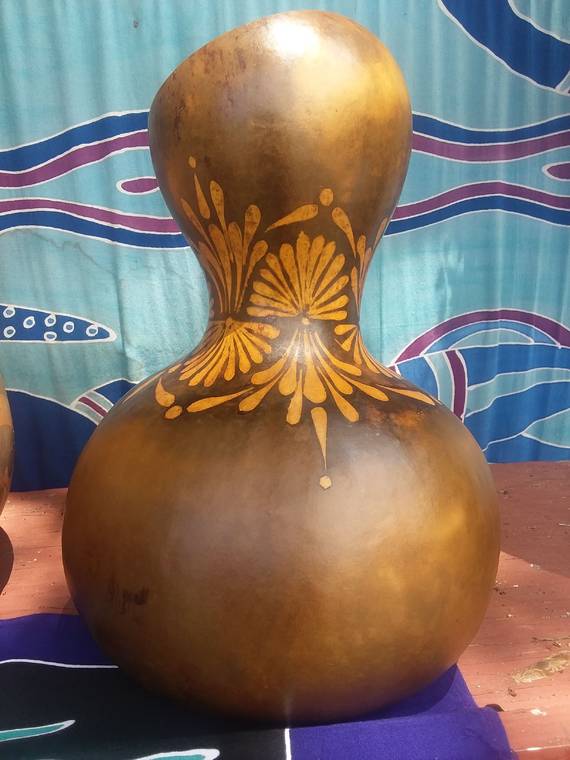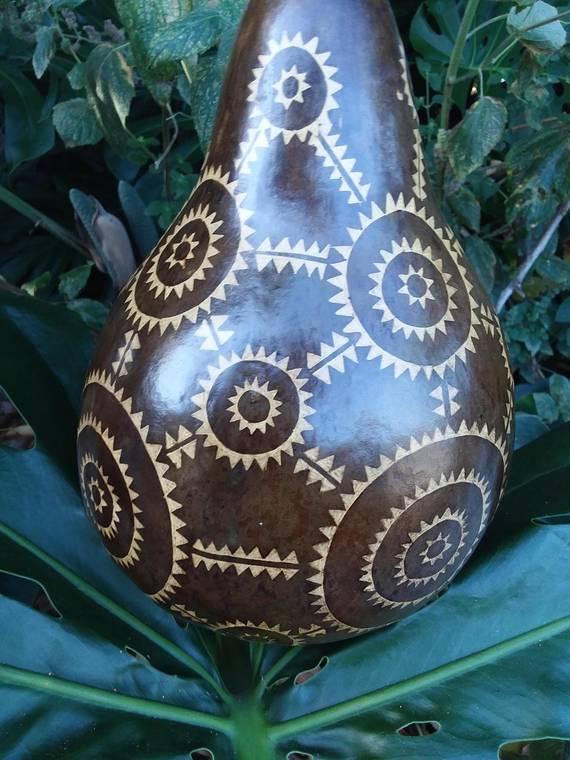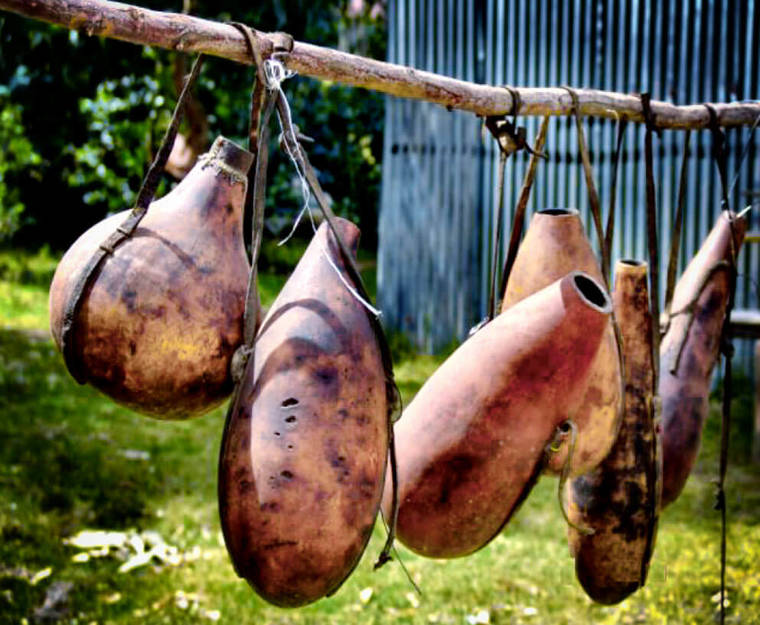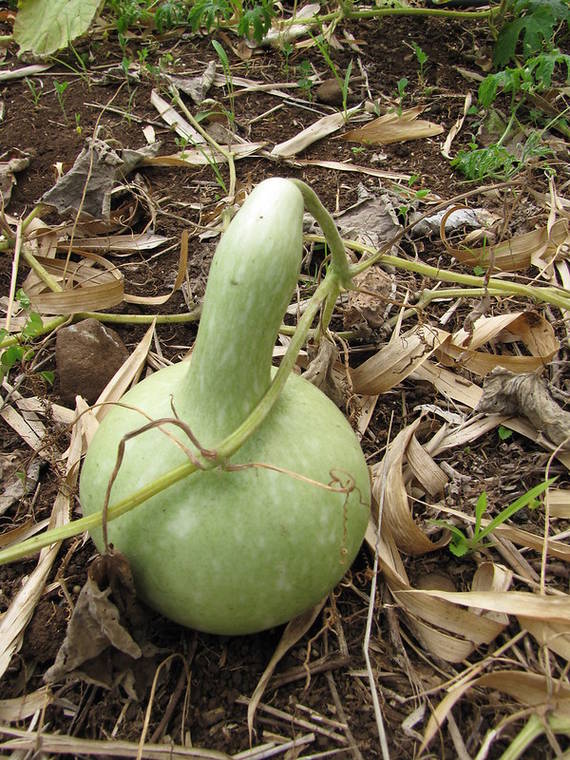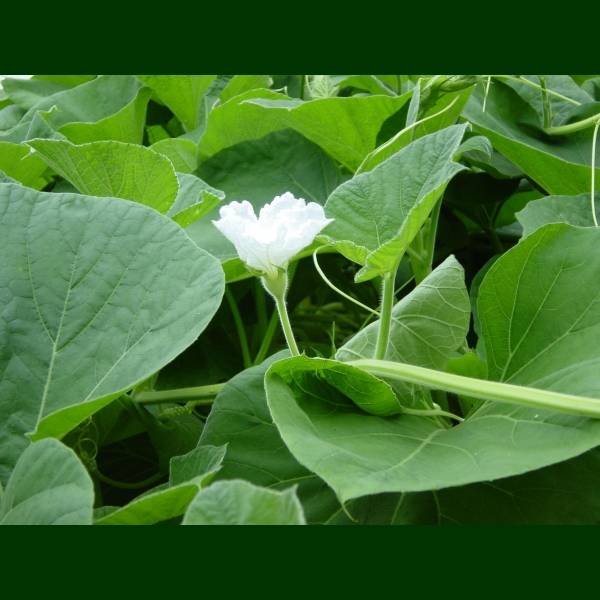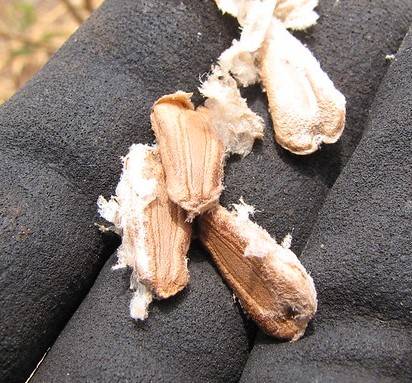Growing ipu gourds in Kona can be challenging but well worth the effort. Everything from planting the seeds to pruning the vine as well as pollinating the flowers and harvesting the gourd has a long tradition in Hawaiian culture.
You may want to follow cultural protocol especially if you want to make ipu heke or other instruments for hula. If you simply want to create artistically designed containers or simple planters, the growing process is less tradition-bound but the resulting shape of your gourd requires some planning.
The Niihau method is a traditional way to decorate ipu gourds though other techniques can be found online. The results can be a wonderful art piece that you grew and decorated yourself.
The vine that produces the ipu gourd (Lageneria siceraria) is actually native to parts of Africa and tropical Asia. It is in the squash or Cucurbitaceae family and is closely related to edible squashes as well as watermelons and cucumbers. The six species and numerous gourd varieties in the Lagenearia or calabash genera trace their name to the Latin word “lagena” for bottle and are not usually grown for food.
Ipu gourds were very important plants for the Polynesians. They had been used for centuries and proved very useful on the voyages to Hawaii. They not only held water, food and supplies but were also used to bail bilge from their canoes. The Polynesians brought ipu seeds to Hawaii along with the 23 other “canoe plants” and planted them upon arrival.
An important part of the Hawaiian tradition for growing ipu starts with the planting. The old Hawaiian word for ipu water containers was hua wai, “the fruit that holds water.” The best time for planting ipu then was when the moon was in its hua phase. This occurs three or four days before the full moon.
Part of the traditional wisdom includes planting ipu seeds at the end of the rainy season to avoid molding of the gourd from too much rain. Since our rainy season in Kona is drawing to a close, October would be a good month to plant ipu. As it turns out, we will have a hua moon this coming Thursday or Friday. If you have seeds you have a few days to prepare to plant.
The Community Seed Library at the Kailua-Kona public library has lots of ipu seeds in their file. Go by and get a packet. You can also order some from www.mauiseed.com or check with local growers who might have seeds. If you aren’t ready to plant your ipu by this hua moon you can wait a month or more to plant.
For best results place ipu seedlings in a sunny spot at lower, warmer elevations. Though the seedlings and young plants may need a constant supply of water to get started, they will do fine with less water once they start to flower and fruit.
Ipu gourds grow on a climbing vine that does best with some kind of support or with plenty of ground to spread out. The plants have dark green, heart shaped, sometimes lobed and hairy leaves that can be 12 inches or more across. Some growers trim back the central vine to increase flowering and fruiting on lower, side branches. The vines will produce white male and female flowers within a few months. To insure pollination and good fruit production, hand pollination (male pollen onto female stigma) is advised. As many as 10 gourds can grow on a single vine.
Once pollination is successful, the fruit will begin to form. It can take as short as three or as long as nine months for an ipu to mature. During their growth they need to be protected from pests and well placed to achieve the desired form. Covering the developing fruit with netting or nylon stockings can prevent attack from stinging insects.
Supporting the vines so that the fruit hangs off the ground can prevent mold. If you want the bottom to be flat at maturity, the fruit needs to sit on a flat base but if it grows on the ground it is susceptible to rodents and rot and will probably develop a curved top. Some growers bind the fruit to create a desired form. Do some experimenting to find the ideal growing technique to produce the shape you want.
Once the stem of the gourd turns brown, the ipu is ready to harvest. At this point it may be completely white or very light green. If you want to decorate your new ipu, start within a week or two of harvest.
The traditional Niihau style, according to Mary Elizabeth Amos, involves using a fine pen to draw a design then carving it out with an X-Acto knife and removing the skin from the parts you don’t want dyed. After four or five days fill the gourd with dye (coffee, even instant, can be used). You can leave the seeds and pulp in during the dyeing process.
Replenish the dyeing liquid so that the gourd remains full for a month to six weeks. Once the dyeing is finished, clean out the gourd and remove all the old skin to reveal your pattern. Dry the gourd, lightly sand it and apply tung oil annually to retain a nice finish. The results can be as simple or intricate as you like.
Growing this traditional Hawaiian plant successfully can be very satisfying, especially if you take the time to pre-determine its desired use and shape and have an interest in turning the fruit from your garden into a lovely piece of art.
Peter VanDyke from Amy Greenwell Ethnobotanical Garden and Mary Elizabeth Amos founder of the Hawaii Gourd Society and the nonprofit, Ipu Lani shared valuable information for this article.
Diana Duff is a plant adviser, educator and consultant living part time in Kailua-Kona.
Gardening Events
Saturday: “Work Day at Amy Greenwell Garden” from 9 a.m. to 12:30 p.m. Meet at the Garden Visitor Center across from the Manago Hotel in Captain Cook. Volunteers will be able to help with garden maintenance and are invited to bring a brown bag lunch. Water and snacks provided. Call Peter at 323-3318 for more information.
“Mac Nut Pest Workshop” from 9:30-11:30 a.m. at Ahualoa Farms, 47-4508 Cane Haul Road, Honokaa. Dr. Alyssa Cho of UH CTAHR will teach macadamia nut pest management with a focus on macadamia felted coccid. Free workshop but space is limited to registered participants. For questions, text or call 430-1876 or email bigislandmacnut@gmail.com. Register at https://www.eventbrite.com/e/macadamia-nut-pest-workshops-tickets-67565525305.
Farmer Direct Markets
Wednesday: “Ho’oulu Farmers Market” 9 a.m. to 2 p.m. at Sheraton Kona Resort &Spa at Keauhou Bay
Saturday: “Keauhou Farmers Market” 8 a.m. to noon at Keauhou Shopping Center
“Kamuela Farmer’s Market” from 7:30 a.m. to 1 p.m. at Pukalani Stables
“Waimea Town Market” from 7:30 a.m. to noon at the Parker School in central Waimea
“Waimea Homestead Farmers Market” from 7 a.m. to noon next to Thelma Parker Gym in front of Thelma Parker Library.
Sunday: “Pure Kona Green Market” 9 a.m. – 2 p.m. at Amy Greenwell Garden in Captain Cook
“Hamakua Harvest” 9 a.m. to 2 p.m. at Highway 19 and Mamane Street in Honokaa
Plant Advice Lines
Anytime: konamg@ctahr.hawaii.edu
Tuesdays &Thursdays: 9 a.m. to noon at UH-CES in Kainaliu – 322-4892
Mon., Tues. &Fri: 9 a.m. to noon at UH CES at Komohana in Hilo 981-5199 or himga@hawaii.edu







